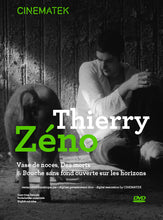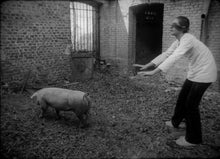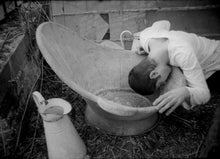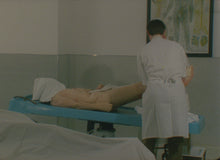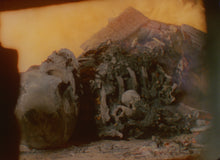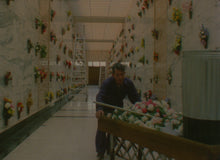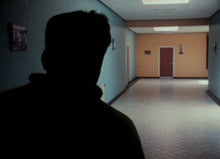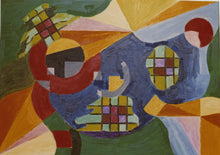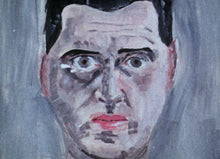
Belgian film-maker and visual artist Thierry Zéno left behind a body of work that, in many respects, is both shocking and fascinating. The film that really introduced him to the world was Wedding Trough, a disconcerting film influenced by Rops and Pasolini about the life of a solitary man in love with a sow. Of the Dead, a documentary showing images that at times are hard to watch, between the ethnology of the morbid and the avidity of the voyeur, is beyond doubt the most candid cinematographic confrontation with death. This edition also includes Zéno’s first film, Bouche sans fond ouverte sur les horizons, a documentary about the work of a schizophrenic painter held in a psychiatric hospital.
CONTENT
DVD 1
Wedding Trough (1974, 78')
“A man loves a sow. Piglets are born. He hangs them. Driven to despair, the mother commits suicide. Then comes advancing decay and the devouring of shit, followed by the disappearance of the man, his body flying through the sky.” Few films manage, with just a few rudimentary sentences, to create such unease, such a feeling of shame. And yet, in spite of the accuracy of Jacqueline Aubenas’ text, no prior description really prepares you for the shock, physical, mental, cinematographic, that is Wedding trough. At the age of 24, after studying film directing at the Institute of Broadcasting Arts, Thierry Zéno shoots this feature film, with no dialogue and in black and white, together with Dominique Garny, the film’s extraordinary alchemist hermit, and Jean-Pol Ferbus. Shown in 1974 at the final edition of EXPRMTL 5, the Knokke Experimental Film Festival, where it won a prize, this metaphysical, poetic and subversive fable travels the world over the years, provoking both fascination and rejection. At the Visionary Belgium exhibition in 2003 at BOZAR, the Centre for Fine Arts in Brussels, Harald Szeeman (curator and jury member at Knokke) grants it pride of place between The Lady with the Pig by Félicien Rops and The Tattooed Pigs by Wim Delvoye. (Muriel Andrin, Université Libre de Bruxelles)
DVD 2
Of the Dead (1979, 99')
Joining the long line of ethnographic documentaries, Of the Dead and its crystal-clear title takes us to three continents and six countries (USA, Mexico, Belgium, South Korea, Thailand and Nepal) to discover the disturbing world of funeral rituals. Made by Zéno, Garny and Ferbus, with Alain Pierre responsible for the music, the film is the result of two years of meticulous bibliographical research prior to two years of shooting, followed by a year spent editing 30 hours of film. It compares cultural variations, contrasting the intimate, family relationship with commercial and brutally industrial rituals. Influenced by Cinema Verite, the film shares with Wedding Trough the idea of cinematographic shock and the same limits to what can be shown. This vision of death at work has a sublime beauty about it and is, at times, difficult to bear. Because the bodies that are cared for, washed, frozen, rot, that burn in the heat of the flames, wither in the open air or change as insects set to work on them, are human bodies like ours, inexorably reminding us of our own finiteness. A thanatological film, a unique and deeply memorable experience, Of the Dead uncompromisingly explores what Amos Vogel called the last great taboo of cinema. (Muriel Andrin, Université Libre de Bruxelles)
Bouche sans fond ouverte sur les horizons (1971, 26')
In 1971 Thierry Zéno creates a fascinating portrait of artist Georges Moinet in the form of a 16 mm medium-length film. A schizophrenic who lives in a psychiatric hospital near Namur, Moinet paints. After being mute for 24 years he chooses this cinematic encounter to explain his artist approach, revealing what lies behind his personal cosmogony. But this long logorrhoea proves disturbing and fails to provide possible clues to understanding his work, gradually becoming a form of music that blends in with the sounds and distant, invisible hubbub of the hospital. With Alessandro Ussai behind the camera and Roger Cambier responsible for the sound, Zéno gets up close to Moinet to better capture him in all his demiurgical excessiveness, his existence on the fringes but also his humanity, deconstructing in a series of very tight shots the man and his canvasses. Subtly thwarting all didactic perspective traditionally associated with a film about art, Zéno confronts us with outsider art, in the same way that he later does with Rops’ painting or Ionesco’s language; his aesthetic choices result in his film recreating the shock of his meeting with the artist and already shows him moving into the fringes himself. (Muriel Andrin, Université Libre de Bruxelles)
Language: French, English, et al.
Subtitles: Dutch, French & English
PAL / All regions




















